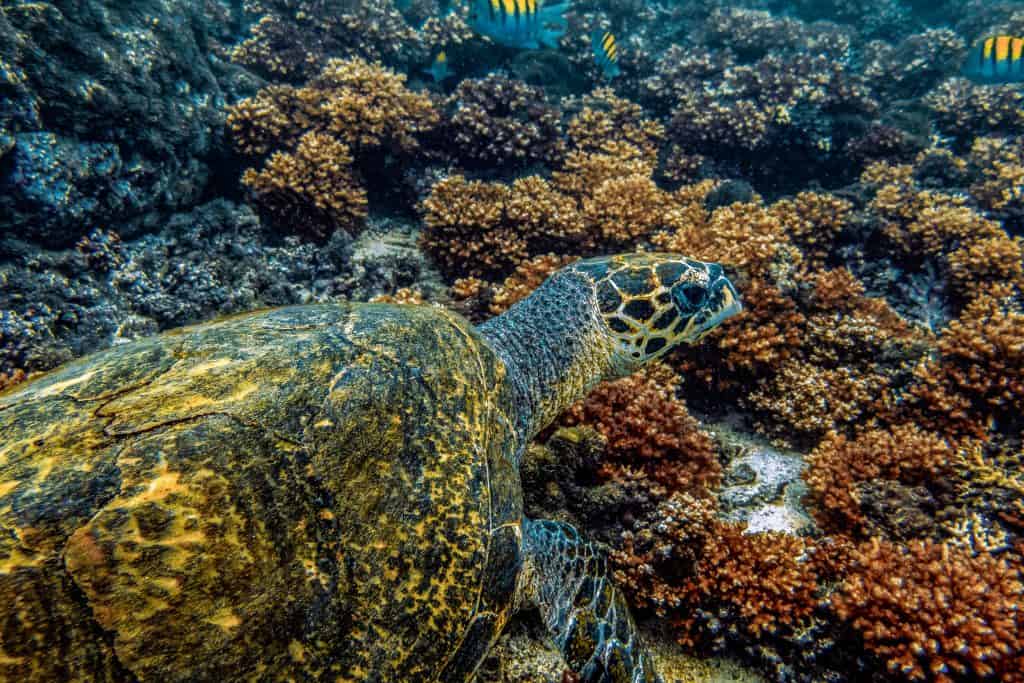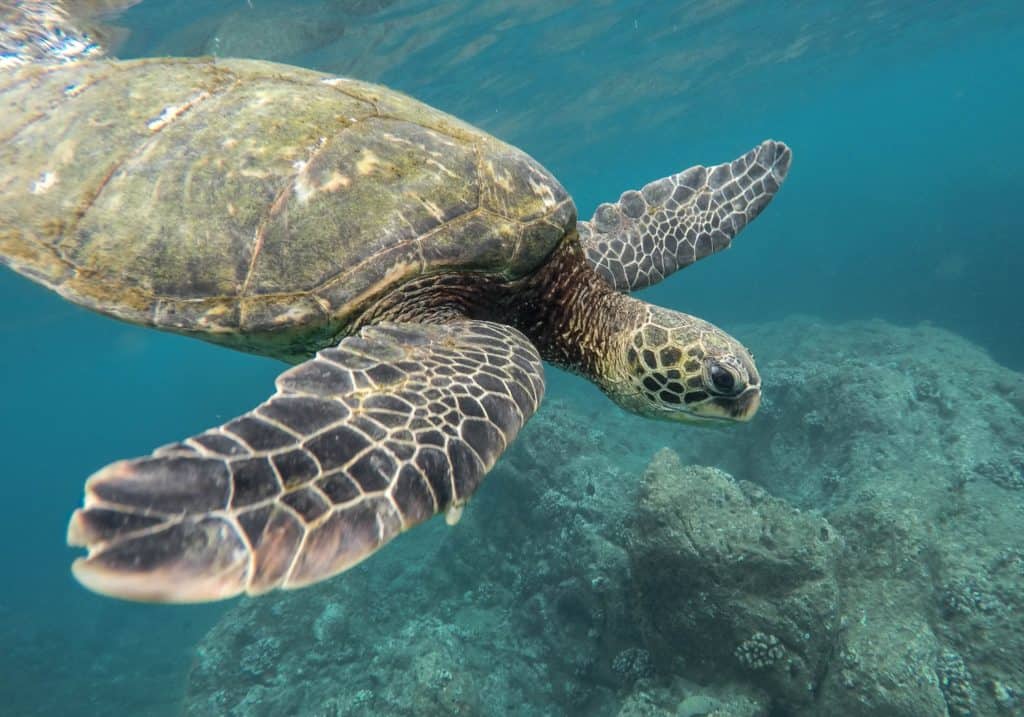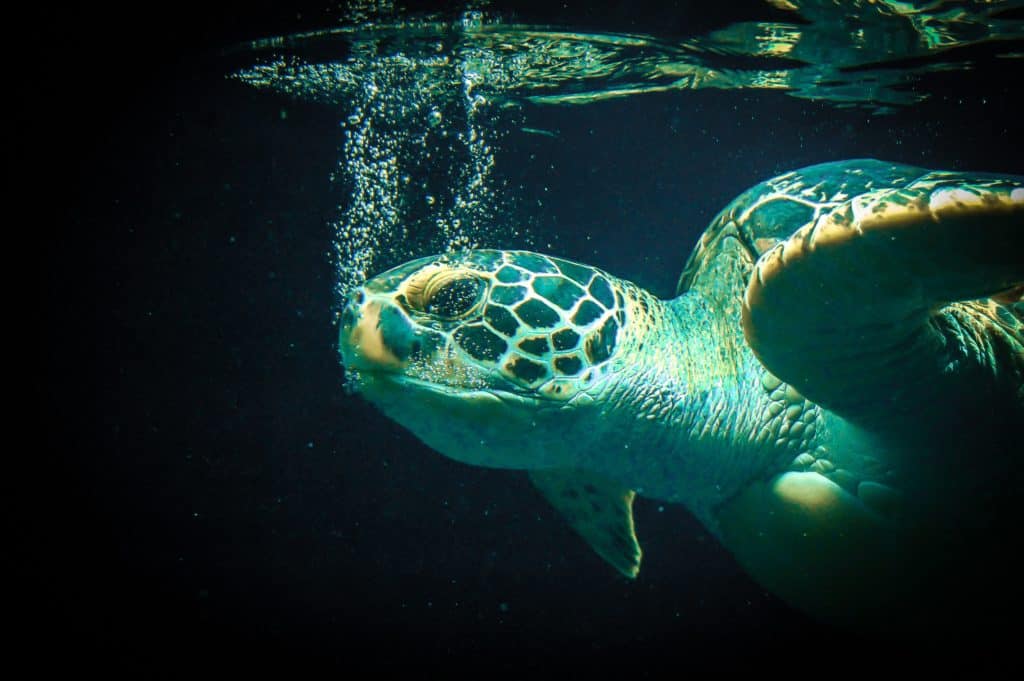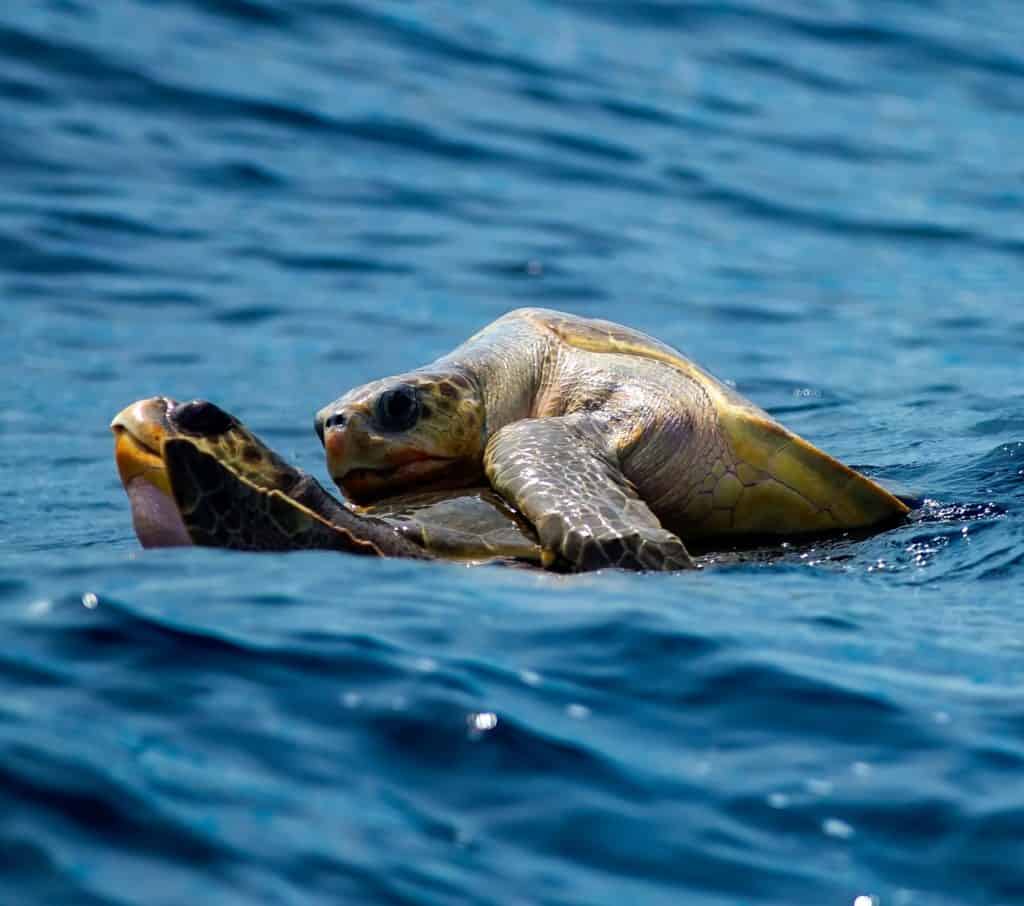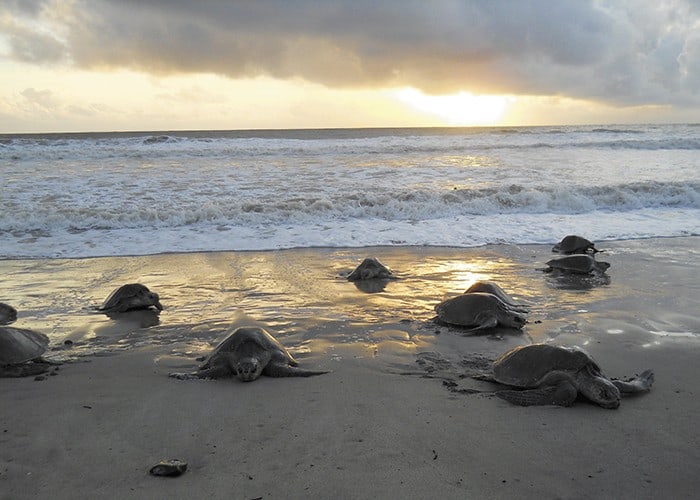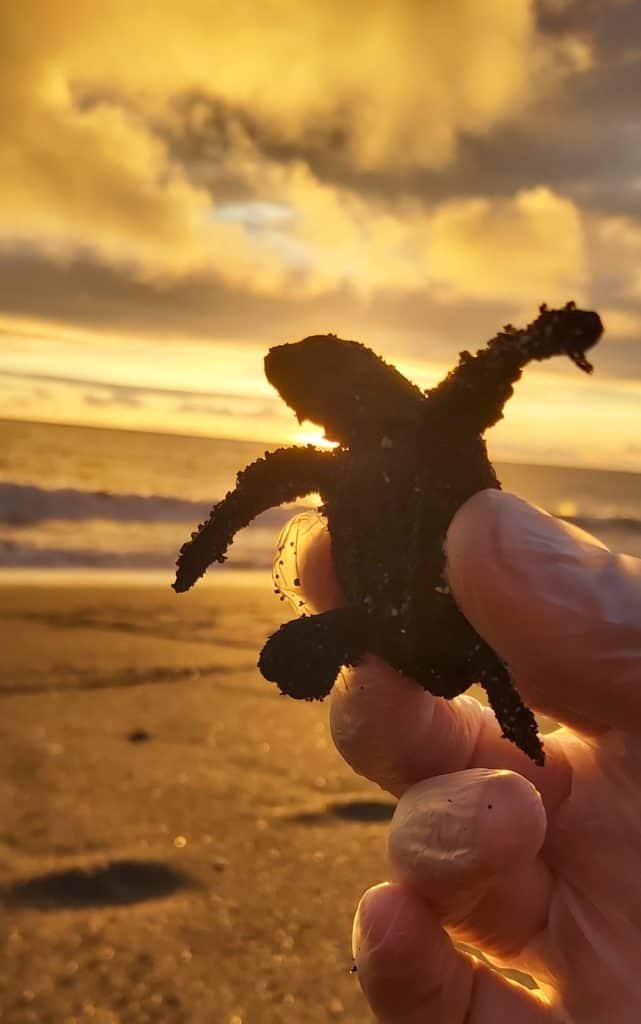For me, sea turtles, dolphins, and whales are some of the most iconic and lovable creatures in the ocean. But, is there anything more adorable than a baby sea turtle?
What kind of animal sea turtles are?
The sea turtles are reptiles, they have other close cousins, the tortoises are land animals and terrapins live on land and in water, usually in swamps, ponds, lakes, and rivers.
As reptiles are ectothermic, meaning they rely on the environment to regulate their body temperature, and sea turtles are no exception.
Their streamlined and hydrodynamic shell and powerful large flippers allow them to dive to great depths and swim long distances.
These ancient creatures, which have been swimming around the oceans before the age of the dinosaurs about 120 million years ago, are some of the oldest creatures on the planet, but may yet disappear if we do not act to conserve them.
How many sea turtles’ species exist?
There are eight species of the marine turtle: Leatherback, Hawksbill, Loggerhead, Green, Black, Flatback or Australian, Olive ridley, and Kemp’s ridley.
Panama is home to 5 species of sea turtles: loggerhead, leatherback, hawksbill, green and olive ridley our warm coastal waters and protected beaches offer good habitats for sea turtle nesting.
Where do sea turtles live?
Sea turtles can be found in the world’s oceans, except for the polar seas, these stunning creatures glide effortlessly through the sea.
There are very adaptive don’t matter about water temperature. Males never leave the ocean, while females will come ashore to lay their eggs on sandy beaches during the nesting season.
Some sea turtles migrate very long distances, about 12,000 miles, while others stay close to home
Leatherbacks and loggerheads can travel thousands of miles each year, while greens and olive ridleys have shorter migrations, while hawksbills rarely leave a relatively small area.
Why do sea turtles are so important?
Sea turtles play a critical role in maintaining the health of the oceans, especially sea beds and seagrass beds, and coral reefs, benefiting many commercially valuable species such as shrimp, lobster, and tuna.
How long do sea turtles live?
They have similar lifespans to humans; some can live up to 50 years or more. Green turtles are a long-lived species and can live for 70 years but they can achieve 100 years. Female sea turtles reach maturity at 20 to 35 years and will continue to nest for 10 years or more.
What do sea turtles eat?
Turtles don’t have teeth; they use their beak-like mouth to grasp their food. This beak is made of keratin (the same stuff your fingernails are made of).
Diet varies depending on the species. Most are omnivorous, sea turtles use to eat squid, barnacles, sponges, and sea anemones, among other creatures, but generally, they think jellyfish are delicious and help to keep their populations in check.
Each species focuses on a different kind of food
They have color preferences because they like red, orange, and yellow food than others when looking for a meal.
Hawksbills eat primarily sea sponges typically found on coral reefs. They are named for their raptor-like jaws, the shape and sharpness of their beak enable them to reach into small holes and crevices in coral reefs to find food.
Green sea turtles are unique among sea turtles in that they are primarily herbivores, eating mostly seagrasses and algae. This diet is what gives their cartilage and fat a greenish color (not their shells), which is where their name comes from.
Leatherbacks eat mostly jellyfish, salps, and other soft-bodied animals and have spiny “papillae” lining their mouth and esophagus to help them swallow this slippery prey.
Loggerhead sea turtles, named for their relatively large heads, have powerful jaws for cracking hard-shelled prey like whelks and conchs.
Plastic bags look like jellyfish when it’s floating in the water and that’s why so many turtles die from eating plastic, they were going for a tasty snack and found the dead
Sea Turtles Can Breathe Underwater?
These creatures are well-adapted to the ocean though they have lungs and require fresh air to survive.
During routine activities, turtles can hold their breath for 45 minutes to 1 hour. However, they usually dive for about 5 minutes, and then in between the dives, they come to the surface to breathe air for a few seconds.
Sea turtles are deep divers and can stay underwater for long periods. They even sleep underwater.
Green turtles can hold their breath underwater for as long as five hours. To do this, they slow their heart rate to up to nine minutes in between heartbeats to conserve oxygen!
Leatherbacks dive much deeper than other turtles, regularly reaching depths beyond 1,000 m, deeper than most marine mammals.
Despite this adaptation, a stressed turtle – such as one entangled in a ghost net – will deplete oxygen stores rapidly and may drown within minutes if unable to reach the surface.
Why sea turtles don’t retract into their shells?
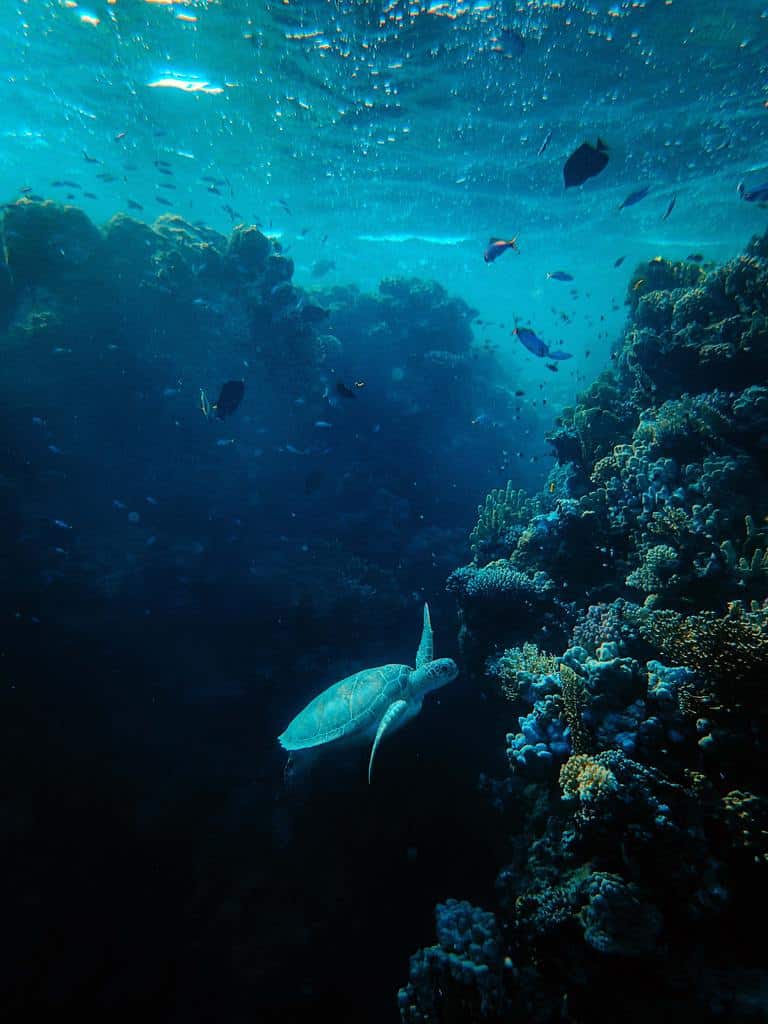
Unlike other turtles, sea turtles cannot retract their flippers and head into their shells. Their streamlined shells and large paddle-shaped flippers make them very agile and graceful swimmers, but unable to do it.
Turtle shells are made of over 50 bones fused, is a modified ribcage, and part of its vertebral column – so they’re wearing their bones on the outside. They also have light, spongy bones that help them float.
The shell is covered by plates called scutes. Scutes are made of keratin, the same material that makes up humans’ fingernails.
Seven of the eight sea turtle species have hard shells; are made of thick plates called scutes.
Leatherback turtles are the outliers. Their shells are more supple and akin to leather. Its carapace is almost rubbery to the touch and somewhat flexible, can absorb nitrogen and collapsible lungs that allow them to compress themselves while diving to cope with the pressure change. Allows it to dive to great depth to find food, more than 1,000 meters.
The shell can do more than protect and streamline. Many other ocean organisms use sea turtle shells as a home or a feeding station. Small organisms, called epibionts, can live on the surface of a sea turtle’s shell. They can include barnacles, algae, and even small crabs.
If a sea turtle gets too many hitchhikers on its shell, it can become weighed down and have a harder time moving. Thankfully for sea turtles, certain fish love to eat the epibionts—the sea turtle gets a cleaning while the specialized fish swim away with a nice meal.
Can sea turtles feel it when you touch their shell?
Yes, they have nerve endings connections to the bones of the shell. These nerve endings are sensitive to pressure, for example from a touch on the back.
It’s the same sensation that you feel when you touch your fingernails.
When are in pain, turtles become inactive, depressed, or suffer from loss of appetite.
How much do sea turtles weigh?
Leatherback turtles also are the largest sea turtle and can weigh a whopping 2,000 pounds.
Kemp’s ridley and olive ridleys are the two smallest species of sea turtles with only 75-100 pounds.
How fast can be swim?
Their bodies turned into an efficient swimming machine, able to move with power and gracefully through the water.
Generally, there are not extremely fast swimmers. Usually, they cruise at around 0.9 to 5.8 mph (1.4 to 9.3 km/h) but they could swim up to 22 mph (35 km/hr) when frightened.
The large and strong front flippers act like paddles to propel them through the water, while the smaller back flippers function as rudders to help them steer.
How do sea turtles reproduce?
Across all species, sea turtles are not social creatures, while they typically don’t mind if there are other turtles around them, they don’t interact or socialize.
Most are loners that only come together during the mating season. It takes 10-30 years for a sea turtle to reach sexual maturity.
Mate with those rigid bodies, it will surely not be an easy task
During the mating season, breeding females and males both return to the shore where they were born, females know it’s a suitable nesting location, while males know they’ll find females there.
Males generally arrive much earlier than females, because sea turtle mating runs on a first-come-first-serve basis.
Is almost a mystery, Why do sea turtles nest on some beaches and not on others? Not only do they appear on the same beach, they often emerge within a few hundred meters of where they last nested.
Is a rough act, like 50 shades of gray, the sea turtle version
During mating season, males may court a female by nuzzling her head or by gently biting the back of her neck and rear flippers.
If the female allows it, a male will climb onto a female’s back while she is swimming horizontally in the water. On their front flippers, males have long claws, which they use to hook onto the leading edge of the female’s shell — these claws are quite sharp and will often scratch the female shells and cut into the female’s soft flesh near her shell.
When the male attaches himself to the back of the female’s shell, he then folds his long tail under her shell to copulate. This act can take place either on the surface or underwater.
Sometimes several males will compete for females and may even fight each other
The female mate as many times as she can, with different males and stops mating once she has enough sperm to fertilize all of her clutches for the season, she can store the sperm for several months. Her eggs will have been fertilized by a variety of males, maybe to ensure genetic diversity.
Only female sea turtles return to their natal beach
A few days later, the female will climb onto the beach where she was born, even if she has not been there for 20 years!
They swim through the crashing surf and crawl up the beach carefully searching for a nesting spot above the high-water mark. Using her back flippers, the reptile digs a nest in the sand. Digging the nest and laying her eggs usually takes from one to three hours.
Hawksbills build their nests faster than any other sea turtle species, typically completing the exacting process in less than 45 minutes.
Lay her first clutch of eggs, bury them under the sand, and then slowly drags herself back to the ocean; once a mom has left her nest, she never returns to tend it.
During this ordeal, she can be easily disturbed and will sometimes abandon the nesting attempt, known as a false crawl.
About two weeks later, she’ll return to the beach to lay her second clutch.
In a single season, the female may nest at least twice and lay up to eight clutches before leaving the nesting grounds.
Most sea turtles nest at night—Kemp’s ridleys are the only sea turtles that routinely nest during the day.
Males spend their entire life at sea, they never return to the shore.
This reproductive cycle repeats every year for males and the female will come back every 2 to 5 years
Sea turtles lay about 100 eggs per nest
Each nest could be containing 65 to 180 eggs.
Each egg is about the size of a ping pong ball. It has a yolk and is soft-shelled to prevent it from breaking when dropped into the nest. The softshell also allows the eggs to remain moist and exchange oxygen.
Ridleys have unique nesting habits
The two species of ridley sea turtles – Kemp’s ridleys and the olive ridleys – primarily nest in groups. This phenomenon is called an “arribada,” which is Spanish for “arrival” which makes for especially high drama.
Hundreds to thousands of turtles come ashore across several hours or days and lay thousands to hundreds of thousands of eggs.
There are many theories on what triggers an arribada, including offshore winds, lunar cycles, and the release of pheromones by females.
This nesting behavior reduces the number of eggs and hatchlings that can be killed by predators.
Nesting is a hard work
Sea turtles are generally slow and awkward on land, and nesting is exhausting work.
Female leatherbacks make some strange noises when they’re nesting – some of which sound similar to a human belch.
Why do sea turtles “cry”?
Yes! sea turtles do cry, but not because they’re sad, they drink seawater to hydrate and they need to be able to excrete excess salt.
Sea turtles evolved specialized secretory glands (lachrymal glands) located in the corner of each eye to remove excess salt. The liquid secreted gives the appearance of tears, hence why turtles are often reported to “cry”.
The leatherback sea turtle has extremely large salt glands compared to other species; their glands are more than twice the size of their brains. They require such large salt glands because of their preferred diet of jellyfish. Since jellies are composed of most seawater, the leatherback ingests much more salt while feeding than any other sea turtle species.
Why sea turtle never gets lost?
Several marine animals, including salmon, elephant seals, and sea turtles, disperse across vast expanses of the ocean before returning as adults to their natal area to reproduce.
Sea turtles have a super-sense from birth called imprinting
In the open ocean, sea turtles encounter strong currents; they have only a modest vision, they can only raise their heads several inches out of the water, and there are often no visible landmarks. Even with these limitations, sea turtles regularly navigate long distances to return to the exact spot where they were born to mate and lay their eggs.
They can detect both the angle and intensity of the earth’s magnetic field. Using these two characteristics, a sea turtle may be able to determine its latitude and longitude, enabling it to navigate virtually anywhere and find its way.
Is like an internal compass or even better than a global GPS system and always head in the right direction.
How were the sea turtles born?
After the future mom lays the egg on the nest, it incubates in the warm sand. They are left to their luck, without anyone taking care of them since the high tides and the other wild animals can destroy the nest.
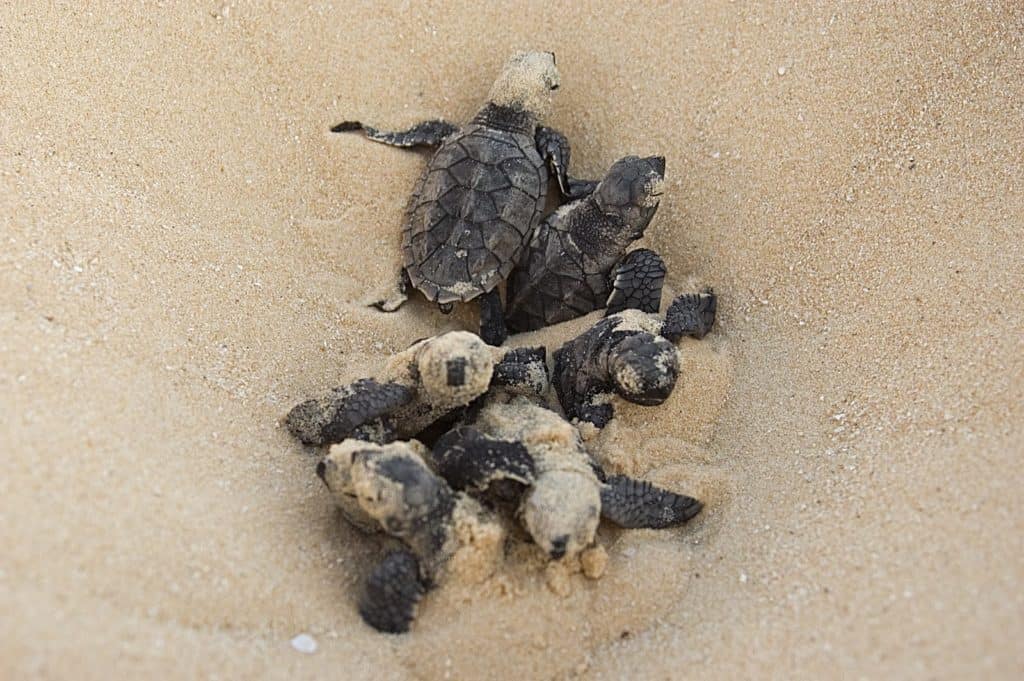
Temperature and humidity are factors that affect the level of success of each nest.
We need to wait from 45 to 70 days to hatch a 2 inches baby sea turtle, we can say there are 3 phases, Incubation, hatching, and racing to the ocean.
All these phases are the most vulnerable life stages, and many become a delicious meal for almost any predator, including humans.
In the Incubation stage, the sand temperature is very important
The sex of sea turtles, like many other turtles, is determined by the temperature in the nest.
Warmer temperatures produce more females and cooler temperatures produce males, for this reason, sea turtles need to lay their eggs when the temperature is just right to produce both male and female hatchlings.
This means sea turtles are affected by climate change, the global warming produces more females and fewer males.
Hatching phase
Baby sea turtles are born with an egg tooth called “caruncle” or “carbuncle” to break out of their egg, which is an extension of the upper jaw which then falls off soon after birth.
When the tiny turtles are ready climb out of the shell. They need time to uncurl their body and shell from the cramped conditions within the egg, the babies begin to dig upward, may take 3 to 7 days to dig their way to the surface.

This may be individual work, but usually, several hatchlings dig together, virtually in harmony, helping one another, creating a scene in the sandy nest that looks like a pot of boiling water.
Newborns usually wait until night to emerge from the nest, maybe to prevent heat exhaustion.
Race to Ocean

We don’t understand, how they know that they must run towards the ocean, possibly the downward slope of the beach, the light reflections on the water, or something inside who let into that direction.
During the crawl to the sea, trash left behind on the sand, any little object or footprint on the sand becomes a big obstacle, the tiny baby turtle turns on an internal magnetic compass, which it uses for navigation, and spot the beach location where she was born
If they are unable to reach the ocean quickly, they can become dehydrated and exhausted, making them an easy meal for predators.
When a newborn sea turtle touches the water and reaches the surf area, it dives into a wave and rides the undertow out to the deep sea and it will continue to “swim” with all four limbs until exhausted, away from shore, and disappear.
Human use of nesting beaches can result in negative impacts to nesting turtles, incubating egg clutches, and hatchlings.
Their Young Lives are a Mystery
The first years of a marine turtle’s life are known as the “lost years”. After entering the ocean, the hatchlings of many species of sea turtles are rarely seen for 1 to 3 years, will spend their early years mostly hiding, eating, and growing.
That’s because the time between when the hatchlings emerge until they return to coastal shallow waters to forage is incredibly difficult to study, we don’t have concrete evidence about what happens to them.
Where do they go? How do they avoid predators? And another 100 questions are still unanswered.
Why are sea turtles endangered?
It’s estimated that only around 1 in 100 marine turtle hatchlings make it to adulthood. This is down to a long time it takes for them to reach maturity and the many dangers faced by hatchlings and juveniles – from predators to marine plastics.
All eight sea turtle species are classified as threatened, two are critically endangered (hawksbill and Kemp’s ridley), one is endangered (green) and three are threatened (leatherback, olive ridley, and loggerhead), due largely to human impact in the form of hunting, bycatch in fishing nets, and climate change affect the coral reefs and feeding area.
Pollution of nearshore and offshore marine habitats threatens all sea turtles and degrades their habitats.
Turtles may ingest marine debris such as fishing lines, balloons, plastic bags, floating tar or oil, and other materials they can mistake for food. Microplastics are an increasing threat to sea turtles, especially young turtles living and feeding near the surface.
Another threat comes from coastal development and illegal sand mining. Natural light at the horizon guides the hatchlings to the ocean. Lights from hotels, homes and other buildings can confuse the turtles into heading the wrong way.
Many are killed for meat and leather, their eggs are taken for food, aphrodisiacs, and mistakenly energizing protein.
In many parts of the world, hawksbills are threatened by hunting for their beautiful shell
Sadly, scientific evidence shows sea turtle populations are dwindling. Scientists estimate that the hawksbill population has declined as much as 90% over the past 100 years.
It was the first plastic material used by humans, and before the Christian era, it was marketed and used in international trade.
Also known as “tortoiseshell,” it is used by craftspeople to create many types of jewelry and trinkets. The historical hunting and killing of hawksbills for their shell nearly drove the species to extinction.


